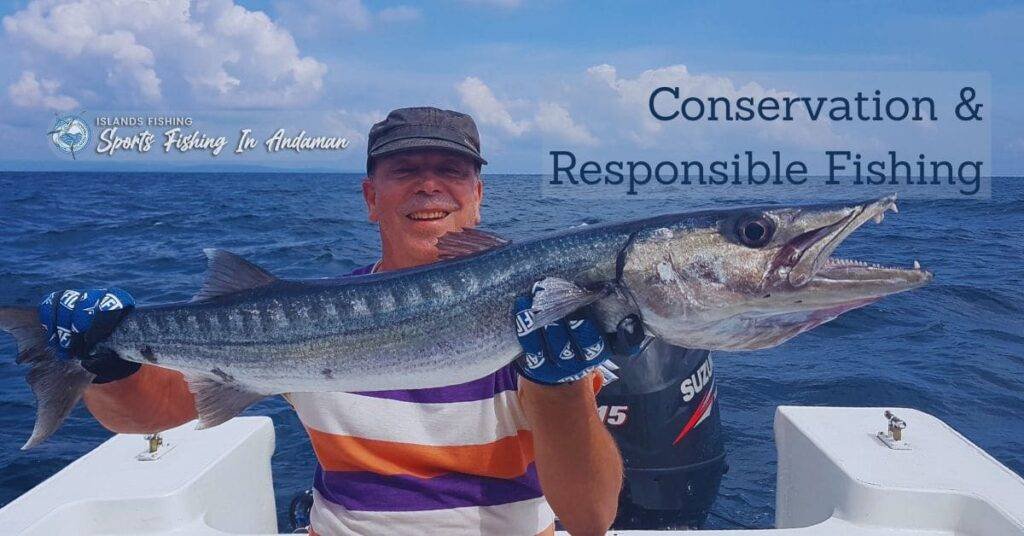When you think of the Andaman Islands, you imagine turquoise waters, pristine coral reefs, and the ultimate angler’s paradise. The archipelago is home to some of the most sought-after game fish species in Andaman — Giant Trevally, Dogtooth Tuna, Yellowfin Tuna, and Marlin, to name a few. But with this natural abundance comes an important responsibility: protecting the ocean that gives us so much.
Sustainable fishing isn’t just a choice here — it’s a commitment to keeping the Andamans wild and thriving for generations to come.
Understanding Catch & Release: A True Angler’s Ethic
For passionate anglers, the real thrill of fishing doesn’t end with the catch — it’s about the chase, the fight, and then letting the fish go. Catch and release is a globally recognized practice that helps maintain healthy fish populations while still allowing anglers to enjoy the sport.
In the Andamans, responsible charter operators follow strict catch-and-release policies for certain game fish species like:
- Giant Trevally (GT) – The king of Andaman waters, known for its brute strength and aggressive strikes.
- Dogtooth Tuna – A deep-water predator and a prized catch for experienced anglers.
- Sailfish and Marlin – Iconic billfish species that are always released to preserve breeding populations.
This practice ensures that these apex predators continue to thrive, keeping the marine ecosystem balanced.
Why Conservation Matters in the Andamans
The Andaman Islands are part of one of the world’s richest and most delicate marine ecosystems. Overfishing, pollution, and careless practices can easily disrupt the fragile balance. That’s why every ethical angler plays a crucial role in protecting this paradise.
Here’s how responsible fishing makes a difference:
- Protects breeding populations: Allowing mature fish to reproduce keeps stocks healthy.
- Preserves marine biodiversity: Each species — from coral fish to predators — maintains ecological harmony.
- Supports sustainable tourism: Responsible practices ensure fishing remains a long-term attraction for visitors.
When you release a fish safely back into the ocean, you’re contributing to the health of an entire marine community.
Best Practices for Responsible Fishing
Whether you’re a beginner or a seasoned angler, following these guidelines ensures a safe and ethical experience:
- Use barbless hooks: Easier on the fish and safer for you.
- Handle fish with care: Wet your hands before touching to avoid removing protective slime.
- Limit air exposure: Release the fish quickly — ideally within a minute.
- Avoid deep hooking: Use circle hooks to minimize injury.
- Follow local regulations: The Andaman authorities enforce sustainable fishing policies to protect endangered species.
Remember — every small action adds up to big results when it comes to ocean conservation.
The Role of Charter Operators in Marine Conservation
At Sports Fishing in Andaman, sustainability isn’t just part of the service — it’s part of the mission. The team takes pride in promoting eco-friendly practices, educating guests, and ensuring every fishing trip leaves minimal impact.
From using eco-safe tackle to guiding anglers on proper handling techniques, their crew ensures that the experience is not only thrilling but also respectful toward the ocean.
By focusing on catch-and-release and targeting non-endangered game fish species in Andaman, they ensure the waters remain vibrant and full of life year after year.
The Future of Fishing in Andaman
The magic of fishing in the Andamans lies in the balance — the harmony between adventure and respect for nature. With responsible fishing practices, we can continue to enjoy the thrill of chasing powerful fish while ensuring the sea stays alive with color, movement, and abundance.
Every time you release a fish, you’re not just letting it go — you’re giving future generations the same opportunity to feel that rush, that tug, that unforgettable moment. So next time you plan a trip to the Andamans, make it about more than just the catch. Make it about conservation, connection, and care.



